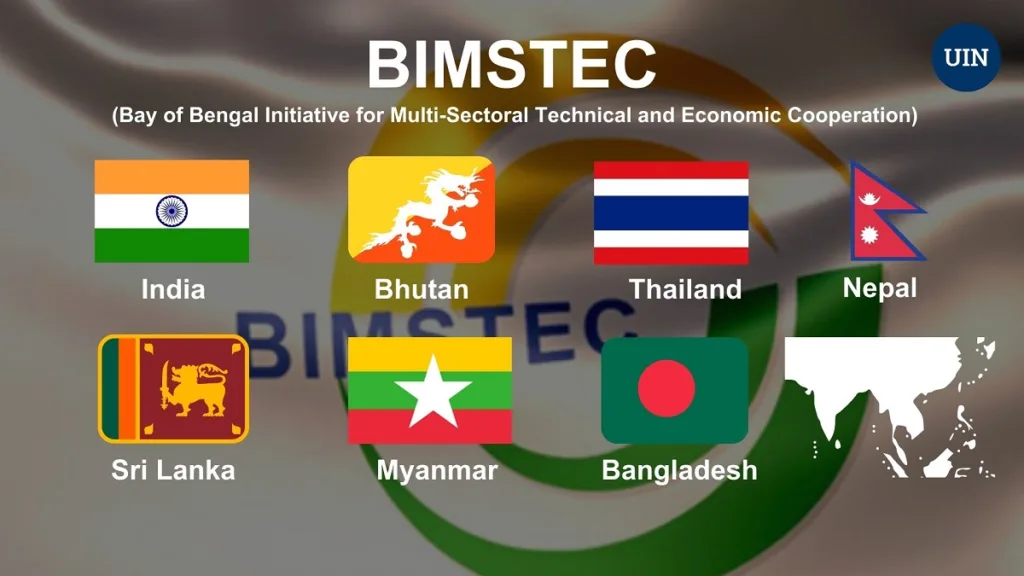The Bay of Bengal Initiative for Multi-Sectoral Technical and Economic Cooperation, commonly known as BIMSTEC, is a regional organization that brings together seven countries from South Asia and Southeast Asia. It was established to promote economic and technical cooperation among its member states and harness the immense potential of the Bay of Bengal region.
BIMSTEC plays a crucial role in fostering regional integration, connectivity, and sustainable development. This article explores the background, objectives, achievements, challenges, and future potential of BIMSTEC.
Table of Contents
Historical Background
It was officially established on June 6, 1997, through the Bangkok Declaration, signed by the founding members – Bangladesh, India, Sri Lanka, and Thailand, known initially as BIST-EC (Bangladesh, India, Sri Lanka, and Thailand Economic Cooperation).
Later, during a special Ministerial Meeting in Bangkok on December 22, 1997, Myanmar was included, leading to the renaming of the group as ‘BIMST-EC’ (Bangladesh, India, Myanmar, Sri Lanka, and Thailand Economic Cooperation). Nepal joined as an observer in 1998, and in February 2004, both Nepal and Bhutan became full-fledged members.
On the momentous occasion of July 31, 2004, the inaugural summit brought forth a moment of transformation, bestowing the alliance with a new identity – BIMSTEC, symbolizing the Bay of Bengal Initiative for Multi-Sectoral Technical and Economic Cooperation.
BIMSTEC Secretariat is in Dhaka, Bangladesh. The organization aims to bring together the countries surrounding the Bay of Bengal, a region rich in cultural diversity, natural resources, and strategic importance, with a combined population of over 1.5 billion people.
Objectives
The primary objectives of BIMSTEC are as follows:
a. Enhancing Regional Connectivity: BIMSTEC aims to improve connectivity among member states through better infrastructure, transportation, and communication links. Enhanced connectivity fosters trade, investment, and people-to-people contacts, contributing to overall regional development.
b. Promoting Economic Cooperation: The organization seeks to strengthen economic ties and cooperation in various sectors such as trade, investment, tourism, energy, and agriculture. This cooperation is vital to unleash the economic potential of the region and uplift the living standards of its people.
c. Addressing Common Challenges: BIMSTEC facilitates cooperation in tackling shared challenges like poverty, climate change, natural disasters, terrorism, and transnational crime. Collaborative efforts are crucial to finding effective solutions to these issues.
d. Cultivating Technological and Technical Cooperation: The organization fosters the exchange of technical knowledge, expertise, and best practices among member states to improve capacity-building in various sectors.
Achievements
Over the years, BIMSTEC has made significant progress in various areas:
a. Trade and Investment: The Framework Agreement on BIMSTEC Free Trade Agreement (FTA) signed in 2004. Within the Framework Agreement, some provisions facilitate negotiations on Free Trade Agreements (FTAs) covering goods, services, investments, and economic cooperation among member nations.
b. Energy Cooperation: BIMSTEC envisions better energy connectivity and collaboration to harness the vast energy resources within the region. The organization has initiated projects related to energy trade, renewable energy, and energy efficiency.
c. Counterterrorism and Security Cooperation: BIMSTEC has been actively cooperating in the fight against terrorism and transnational crime through joint exercises, information sharing, and capacity-building measures.
d. Transport and Connectivity: The organization has been working on improving transport links through the BIMSTEC Transport Infrastructure and Logistics Study (BTILS), facilitating smoother movement of goods and people within the region.
Significance of BIMSTEC
a) Global Weightage: With 22% of the world’s population and a combined GDP of USD 2.7 trillion, BIMSTEC member countries hold substantial economic significance. Their impressive growth rates and the Bay of Bengal’s strategic location for trade further add to their importance on the global stage.
b) Regional Strategic Incentives: BIMSTEC offers strategic incentives to its member states, facilitating cooperation, and overcoming challenges. Bangladesh seeks to elevate its regional status, Sri Lanka aims for Southeast Asian connectivity, while Nepal and Bhutan see it as a gateway to the Bay of Bengal. Myanmar and Thailand view BIMSTEC as a way to access India’s market and balance China’s influence in Southeast Asia.
c) Importance for India: BIMSTEC plays a crucial role in India’s foreign policy objectives of “Neighborhood First” and “Act East.” It provides India with a platform to lead regional cooperation efforts and enhance its geopolitical influence in the Bay of Bengal region.
d) Crucial Against Assertive China: As China invests aggressively in the region through the Belt and Road Initiative, BIMSTEC becomes a battleground for India and China’s struggle for dominance. India can leverage the organization to counter Chinese investments and promote connectivity projects based on international norms.
e) Preserving Peace and Freedom of Navigation: BIMSTEC can promote the Bay of Bengal as an open and peaceful region, in contrast to China’s actions in the South China Sea. The organization can work towards instituting a Bay of Bengal Zone of Peace to limit militarization and ensure freedom of navigation.

BIMSTEC Vs SAARC:
BIMSTEC and SAARC are two regional organizations with distinct characteristics:
| BIMSTEC | SAARC | |
| Scope | BIMSTEC connects South and Southeast Asia | SAARC focuses solely on South Asia |
| Establishment | BIMSTEC was established in 1997 | SAARC was founded in 1985. |
| Relations among Member States | BIMSTEC member countries maintain relatively friendly relations | SAARC faces challenges due to mistrust and suspicion |
| Objectives | BIMSTEC’s core objective is economic cooperation | SAARC often faces issues related to regional politics and power imbalances. |
| Intra-regional Trade | BIMSTEC has higher intra-regional trade (around 6%) | around 5% |
Challenges
Despite its accomplishments, BIMSTEC faces several challenges:
a. Slow Progress: Progress in implementing various initiatives has been slow due to bureaucratic hurdles, divergent national interests, and limited resources.
b. Political Differences: Differences in political systems, historical issues, and border disputes among member states sometimes hamper cooperation.
c. Limited Connectivity: Insufficient infrastructure and connectivity gaps in the region hinder smooth trade and transportation.
d. Funding Constraints: The organization faces funding limitations for its projects and initiatives, which can delay their implementation.
Way Forward
BIMSTEC has considerable potential to become a formidable regional organization. To capitalize on this potential, member states must address the challenges and enhance cooperation in the following ways:
1. Implementation of Agreements: Ensure timely implementation of existing agreements and explore new avenues for collaboration.
2. Trade Facilitation: Work towards reducing barriers and enhancing trade facilitation to boost economic integration.
3. Free Trade Agreement: Explore opportunities for a free trade agreement to further promote regional trade and investment.
4. Strengthening Institutional Mechanisms: Enhancing the institutional setup and decision-making processes will facilitate smoother coordination and implementation of initiatives.
5. Focus on Connectivity: Investing in infrastructure development and regional connectivity will boost trade, tourism, and investment.
6. Economic Integration: Deepening economic integration through trade facilitation, investment promotion, and harmonizing regulations will create a more vibrant economic zone.
7. People-Centric Approach: Encouraging people-to-people contacts, cultural exchanges, and academic collaboration will foster stronger ties among member states.
8. Engaging the Private Sector: Involving the private sector in various projects will leverage expertise, resources, and innovation.
Conclusion
BIMSTEC has the potential to be a transformative force in the Bay of Bengal region by fostering economic growth, sustainable development, and regional stability. Member states must prioritize cooperation, address challenges, and work towards the collective vision of a prosperous and interconnected South Asia and Southeast Asia. As the organization continues to evolve, its success will depend on the commitment and collaboration of its member states and the timely implementation of projects aimed at realizing the shared goals of peace, prosperity, and progress.



